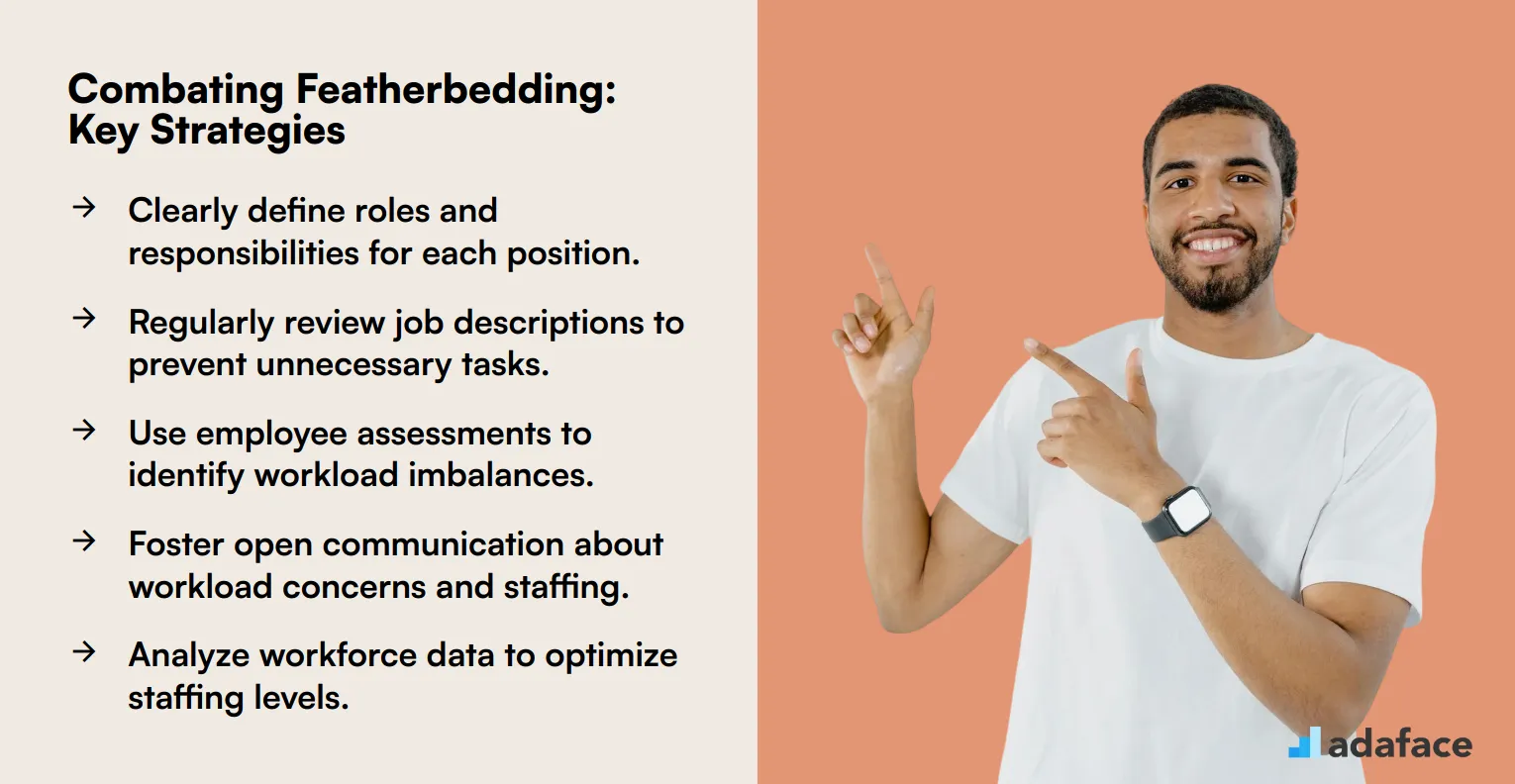Featherbedding in recruitment refers to the practice of hiring more employees than necessary, often due to outdated practices or union agreements. This can lead to inefficiencies and increased costs for organizations, impacting their recruitment strategies.
Understanding why featherbedding occurs is crucial for recruiters aiming to streamline hiring processes. By recognizing common examples and consequences, organizations can implement strategies to identify and prevent featherbedding, ensuring a more effective recruitment process.
Table of contents
What is featherbedding in recruitment?
Featherbedding in recruitment refers to the practice of hiring more employees than necessary for a job or project. This often results in inefficiencies and increased costs for the organization. While it might seem like a strategy to ensure all tasks are covered, it can lead to overhiring, which strains resources and affects team dynamics.
Recruiters and hiring managers may encounter featherbedding when there's pressure to boost employment numbers or when misjudging workload requirements. It can also occur when there's a lack of clarity in job roles, leading to redundant positions. Understanding the objectives of recruitment and selection helps prevent such scenarios by aligning hiring practices with actual business needs.
To tackle featherbedding, organizations can conduct regular workforce assessments to ensure the right number of employees are in place. This involves analyzing current staffing levels and comparing them against operational demands. By doing so, companies can optimize their recruitment strategies and avoid unnecessary hires.
For recruiters, being aware of featherbedding is crucial to maintaining efficiency in the hiring process. It ensures that recruitment efforts focus on filling genuine gaps rather than creating surplus roles. A strategic approach to recruitment not only saves costs but also enhances team performance and morale.
Common examples of featherbedding
Featherbedding can manifest in various forms across industries. Here are some common examples to help you recognize potential instances in your workplace:
Overstaffing: Hiring more employees than necessary for a task or department. This might involve keeping redundant positions or creating roles with minimal responsibilities.
Make-work practices: Assigning unnecessary tasks or artificially extending work hours. For instance, a union might require a company to employ a 'standby' worker who isn't actively needed but remains on-site.
Restricting technology: Resisting or limiting the adoption of new technologies that could improve efficiency. This could involve maintaining outdated processes or equipment to preserve jobs.
Excessive breaks: Taking more or longer breaks than necessary, often under the guise of union-negotiated rights. This practice can significantly reduce overall productivity.
Slowdowns: Deliberately working at a slower pace to extend job duration or create the illusion of busyness. This tactic is sometimes used as a form of protest or to justify additional staffing.
Unnecessary procedures: Implementing or maintaining superfluous steps in work processes. For example, requiring multiple sign-offs for simple tasks that could be handled by one person efficiently.
Why does featherbedding happen?
Featherbedding occurs when labor unions require employers to hire more workers than necessary or maintain employment for workers whose roles are obsolete. This practice can be driven by the desire to protect jobs and ensure job security for union members, even if it leads to inefficiencies for the company.
In some cases, featherbedding may arise from collective bargaining agreements that mandate specific staffing levels, regardless of actual workload needs. These agreements can be a result of negotiations aimed at preserving employment, especially in industries facing technological advancements or automation.
Another reason for featherbedding is to prevent layoffs and maintain union strength, ensuring that the workforce remains robust. By keeping more workers employed, unions can maintain their influence and bargaining power in negotiations with employers.
Featherbedding can also be seen as a strategy to resist the skills gap by ensuring that workers continue to be employed even as the demand for certain skills changes. This can provide a buffer for workers to adapt and retrain for new roles within the company.
Ultimately, featherbedding reflects a complex interplay between labor unions, employers, and the workforce, often influenced by economic conditions and industry-specific challenges. Understanding why it happens can help recruiters and hiring managers navigate these dynamics more effectively.
Consequences of featherbedding in hiring
Featherbedding in hiring can lead to significant financial costs for organizations. By maintaining more employees than necessary, companies face increased payroll expenses without a corresponding increase in productivity. This practice can also create a demotivating work environment. Employees may feel their efforts are undervalued when they see colleagues being paid for minimal work. Over time, this can lead to a decline in overall employee morale and engagement. Furthermore, featherbedding can hinder a company's ability to adapt to changes. With resources tied up in unnecessary positions, the organization may struggle to invest in new technologies or strategies. This inefficiency can negatively impact the company's competitiveness in the market. In the long run, featherbedding may also affect employee retention. Employees may seek opportunities elsewhere if they perceive the organization as stagnant or mismanaged.
Strategies to identify featherbedding
Identifying featherbedding, where employees are paid for work not performed, requires keen observation and strategic techniques. Recruiters and hiring managers must first recognize signs such as unnecessary roles or inflated staffing levels in departments.
Reviewing employment history and job descriptions can reveal discrepancies between job requirements and actual duties performed. This helps in spotting roles that may be redundant or exaggerated, often a sign of featherbedding.
Conducting regular workforce analysis helps in understanding the efficiency of current staffing levels and identifying areas prone to featherbedding. By comparing productivity metrics with staffing levels, recruiters can pinpoint where inefficiencies lie.
Engaging employees in open conversations about workload and responsibilities can also uncover instances of featherbedding. Employees often have insights into their roles and can highlight tasks that are unnecessary or duplicated.
Lastly, leveraging recruitment analytics can provide data-driven insights into staffing patterns, helping identify and address featherbedding systematically. This approach ensures that staffing decisions are based on actual needs rather than outdated practices.

Tips to prevent featherbedding in your organization
Preventing featherbedding in your organization begins with clear communication and setting expectations. Ensure that job roles and responsibilities are well-defined and regularly reviewed to prevent unnecessary positions or tasks from being created.
Implementing a robust performance management system can help identify areas of inefficiency and address them promptly. Regular employee assessments can highlight discrepancies in workload and productivity, allowing for adjustments as needed.
Encourage a culture of transparency where employees feel comfortable discussing workload concerns. This can help identify featherbedding tendencies early and foster an environment of mutual trust and accountability.
Utilize data-driven decision-making to assess the actual needs of your workforce. Regular workforce analysis can provide valuable insights into staffing requirements and prevent overstaffing.
Finally, consider adopting strategic staffing approaches that align with your organizational goals. This ensures that your staffing levels are optimized for current and future business needs, reducing the risk of featherbedding.
Conclusion
Featherbedding in recruitment can significantly impact an organization's productivity and bottom line. By understanding its forms, causes, and consequences, HR professionals and hiring managers can take proactive steps to prevent it.
Identifying and addressing featherbedding requires vigilance and a commitment to ethical hiring practices. Implementing strategies like clear job descriptions, regular audits, and fostering open communication can help create a more efficient and transparent recruitment process.
Ultimately, preventing featherbedding benefits both employers and employees. By maintaining a lean and effective workforce, organizations can thrive, while ensuring fair opportunities for all candidates in the job market.
Featherbedding FAQs
Recruiters can identify featherbedding by analyzing staffing levels, comparing them with industry standards, and evaluating employee productivity. Regular audits and feedback from managers can also help.
Featherbedding often results from outdated union agreements, lack of communication between departments, and resistance to change in hiring practices.
Featherbedding increases operational costs due to unnecessary salaries and benefits, leading to reduced profitability and resource allocation inefficiencies.
Implementing clear hiring guidelines, regular staffing reviews, and leveraging data analytics can help prevent featherbedding. Training recruiters to focus on actual needs is also beneficial.
Addressing featherbedding is important to optimize workforce efficiency, reduce costs, and ensure that the organization remains competitive in the market.

40 min skill tests.
No trick questions.
Accurate shortlisting.
We make it easy for you to find the best candidates in your pipeline with a 40 min skills test.
Try for freeRelated terms



